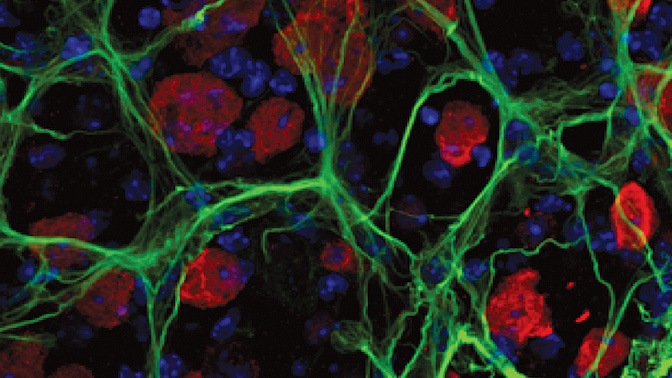Home page Description:
Scientists discover a signalling pathway that could help prevent eye damage.
Posted On: May 11, 2018

Image Caption:
Retinal astrocytes (shown here in green) are star-shaped helper cells that surround the neurons (red) in the retina. Photo courtesy of Alessandra Tuccitto.
Imagine that you’ve been diagnosed with a debilitating eye disease. Your vision suddenly decreases, and you can no longer clearly see your loved ones or the things that matter most to you. It can be a frightening experience.
This irreversible loss of vision, which is a symptom of eye diseases such as glaucoma, occurs when the neurons (nerve cells) that control our sight are destroyed.
While researchers still do not know the exact mechanism by which this occurs, there is evidence to suggest that the accumulation of toxic reactive oxygen species is involved. These toxic compounds damage light-sensitive neurons through a process called oxidative stress. Luckily, the body has specialized cells (astrocytes) that help produce a powerful antioxidant known as glutathione (GSH) that neutralizes the damaging effects of the reactive oxygen species.
Krembil Research Institute Senior Scientist Dr. Jeremy Sivak has been searching for ways to promote the production of GSH in order to halt, prevent or reverse vision loss in patients with eye disease.
His team recently discovered that a protein called adenosine monophosphate-activated kinase (AMPK) increases the production of GSH in astrocytes by activating another key protein known as PGC-1 alpha.
The researchers also demonstrated—using an experimental model of eye disease—that therapeutic compounds that mimic AMPK, increase GSH levels while reducing the death of neurons in the eye.
“Activating PGC-1 alpha represents a novel strategy for enhancing protective astrocyte activity in the eye,” explains Dr. Sivak. “It is an exciting discovery that could not only be applied to eye diseases such as glaucoma, but also other degenerative diseases—such as Alzheimer’s disease—where neurons are damaged by oxidative stress.”
This work was supported by the Canadian Institutes of Health Research, the Glaucoma Research Society of Canada, the Natural Sciences and Engineering Research Council of Canada and the Toronto General & Western Hospital Foundation. J. Sivak is the Toronto General & Western Hospital Foundation Glaucoma Research Chair.
Guo X, Jiang Q, Tuccitto A, Chan D, Alqawlaq S, Won GJ, Sivak JM. The AMPK-PGC-1α signaling axis regulates the astrocyte glutathione system to protect against oxidative and metabolic injury. Neurobiol Dis. 2018 May;113:59-69. doi: 10.1016/j.nbd.2018.02.004.

Dr. Jeremy Sivak, Krembil Senior Scientist. Photo courtesy of the Globe and Mail




